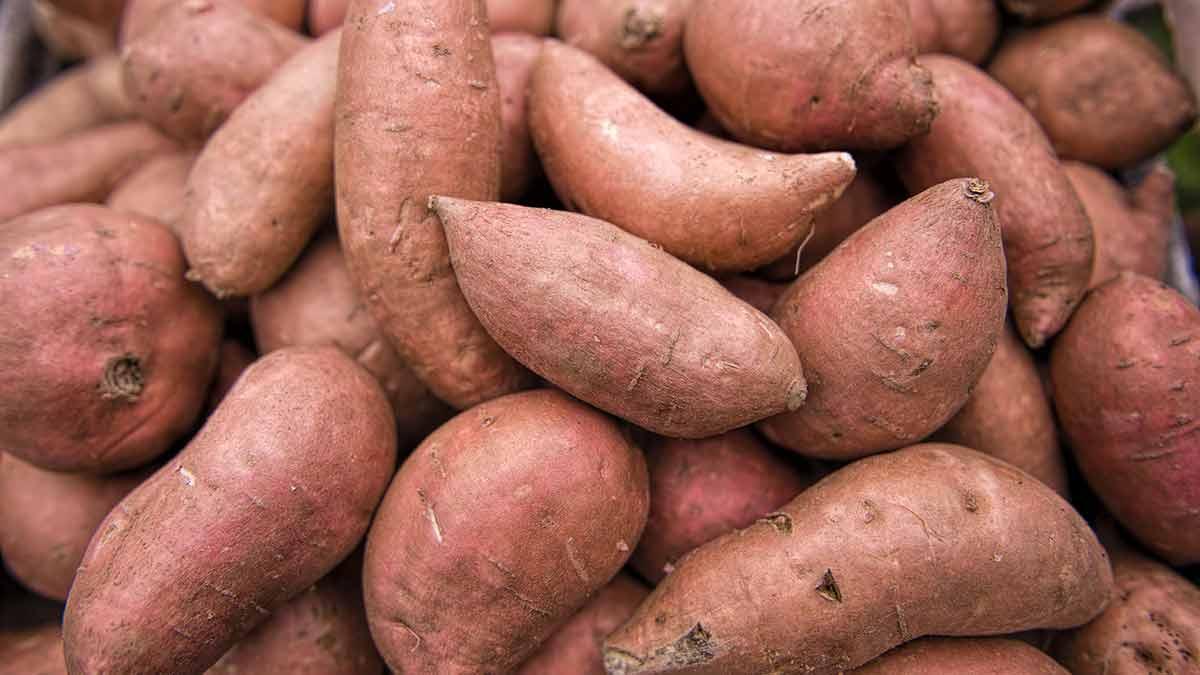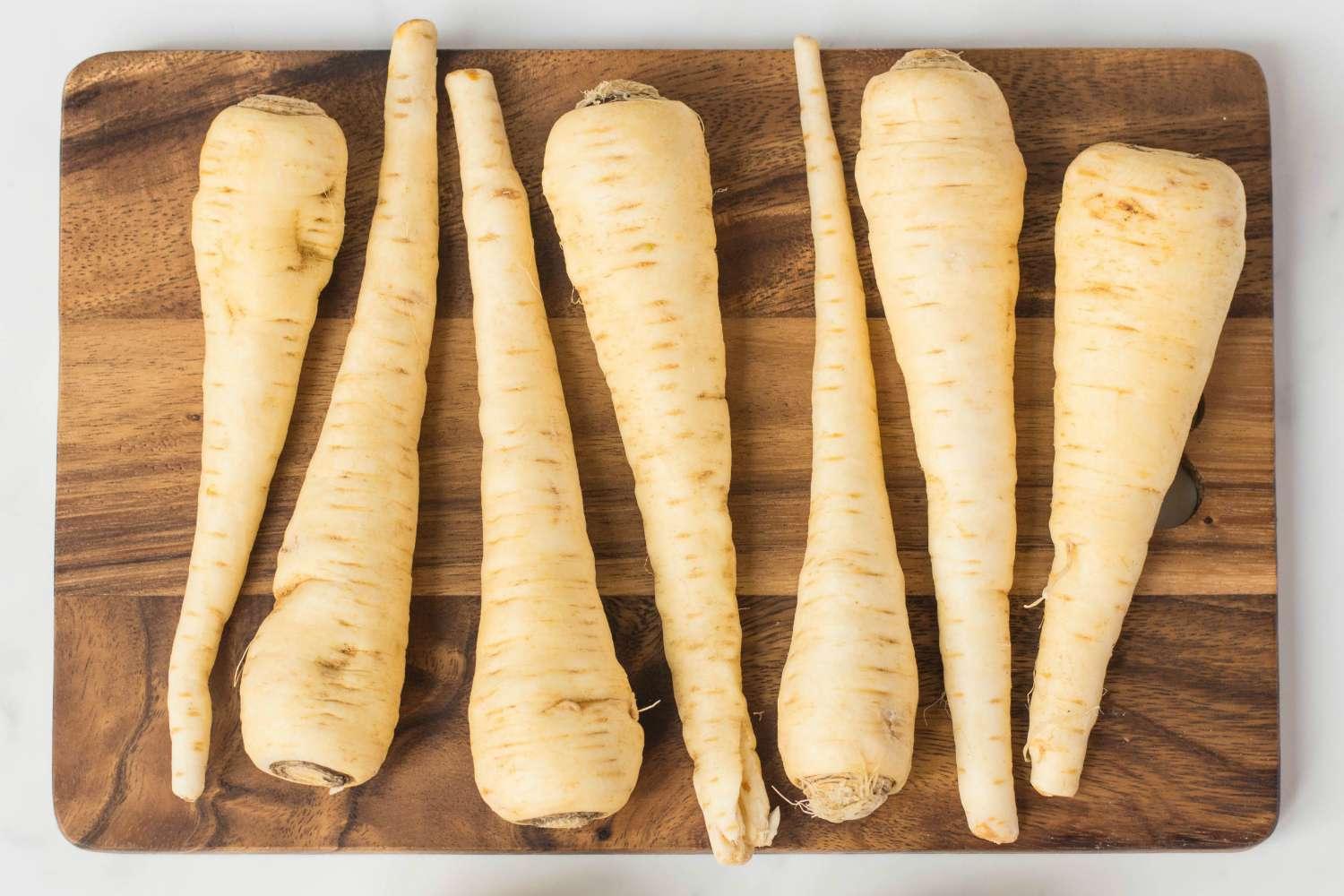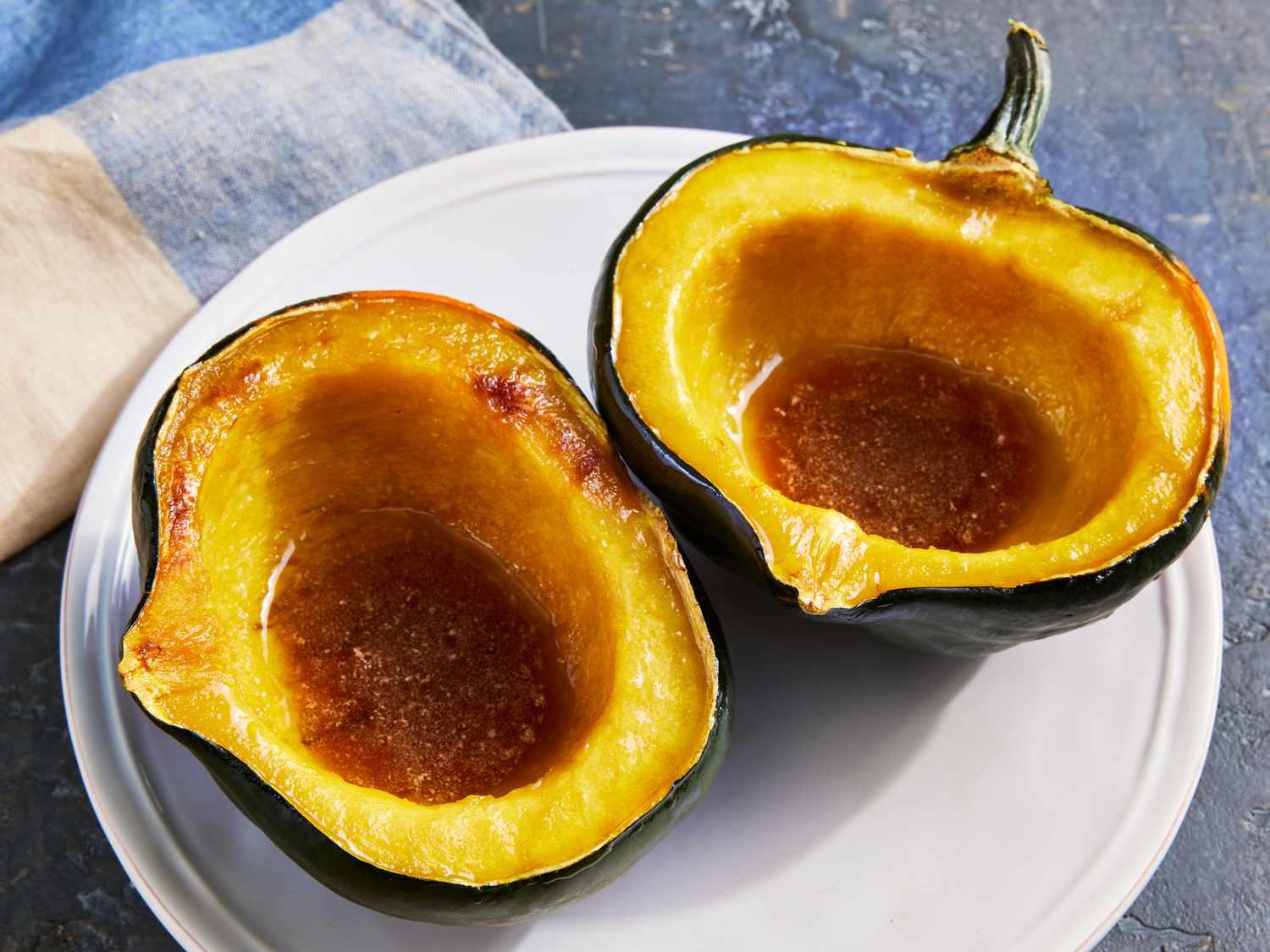19 Starchy Vegetables You Should Try Today

Starchy vegetables are essential to a balanced diet.
They offer a rich source of complex carbohydrates, fiber, and various nutrients.
Often misunderstood and sometimes avoided due to their higher carbohydrate content, these vegetables are crucial in providing sustained energy and supporting overall health.
From the humble potato to the exotic taro, starchy vegetables come in diverse flavors, textures, and culinary applications.
In this blog post, we’ll explore nine popular starchy vegetables, delving into their unique characteristics, nutritional benefits, and versatile uses in the kitchen.
List of Popular Starchy Vegetables
1. Potatoes

Potatoes are the most ubiquitous starchy vegetable, gracing tables worldwide with their versatility and comforting presence.
These tubers come in various varieties, each offering unique flavors and textures.
With their fluffy interiors, Russet potatoes excel in baking and frying, while waxy varieties like red and Yukon gold hold their shape, making them ideal for salads and roasting.
Potatoes are not only a carbohydrate powerhouse but also provide essential nutrients like vitamin C, potassium, and fiber.
- Taste: Mild, earthy flavor that readily absorbs other tastes
- Texture: Ranges from fluffy to creamy, depending on the variety and cooking method
- Versatility: Can be boiled, mashed, roasted, fried, or baked
2. Sweet Potatoes

Sweet potatoes have surged in popularity thanks to their delightful flavor and impressive nutritional profile.
These vibrant orange tubers are a treasure trove of beta-carotene, which the body converts to vitamin A, supporting eye health and immune function.
Unlike their name suggests, sweet potatoes belong to the Morning Glory family and are not botanically related to regular potatoes.
Their natural sweetness lends itself well to savory and sweet preparations, making them a favorite among health-conscious cooks and adventurous chefs.
- Taste: Naturally sweet with hints of caramel when cooked
- Texture: Creamy and tender when cooked
- Versatility: Excellent for roasting, mashing, or using in desserts
3. Corn

Corn, a staple in cuisines worldwide, is a versatile grain that straddles the line between vegetable and grain.
This ancient crop, domesticated by indigenous peoples in Mexico thousands of years ago, has become an integral part of modern agriculture and cuisine.
Sweet corn, the variety most commonly eaten as a vegetable, is harvested while still in its milk stage, preserving its natural sugars and tender texture.
Beyond its delicious taste, corn provides a good source of fiber, vitamins, and minerals.
- Taste: Sweet and slightly nutty when fresh
- Texture: Crisp and juicy when cooked properly
- Versatility: Can be grilled, boiled, roasted, or used in salads and salsas
4. Yams

Often confused with sweet potatoes, true yams are a distinct tuber with a starchier texture and less sweet flavor.
These robust root vegetables are a staple in many African, Caribbean, and South American cuisines, where they’re valued for their hearty nature and long shelf life.
Yams come in various sizes and colors, from small and round to massive tubers weighing up to 100 pounds.
Rich in fiber and potassium, yams offer a nutritious alternative to other starchy vegetables and can be prepared in numerous ways.
- Taste: Mild and starchy, less sweet than sweet potatoes
- Texture: Drier and more fibrous than sweet potatoes
- Versatility: Can be boiled, roasted, fried, or mashed
5. Green Peas

Green peas, those small, spherical vegetables often overlooked in the starchy category, pack a surprising nutritional punch.
These legumes are rich in starch and provide a significant amount of protein and fiber, making them an excellent choice for those looking to balance their macronutrients.
Fresh peas have a vibrant, sweet flavor that diminishes quickly after harvesting, so frozen peas often taste sweeter than their fresh counterparts.
Their versatility in the kitchen makes them a valuable addition to countless dishes.
- Taste: Sweet and slightly grassy when fresh
- Texture: Tender with a slight pop when bitten
- Versatility: Great in salads, soups, stir-fries, or as a simple side dish
6. Butternut Squash

Butternut squash, with its distinctive bell shape and vibrant orange flesh, is a fall favorite that brings warmth and comfort to any meal.
This winter squash is renowned for its smooth, creamy texture and slightly sweet, nutty flavor that deepens with cooking.
Nutritionally, butternut squash is a powerhouse. It boasts high levels of vitamins A and C, as well as a good dose of fiber and potassium.
Its versatility in the kitchen makes it a go-to ingredient for savory and sweet preparations.
- Taste: Mildly sweet with a nutty undertone
- Texture: Smooth and creamy when cooked
- Versatility: Excellent for roasting, pureeing into soups, or using in baked goods
7. Pumpkin

Pumpkin, often associated with autumnal decor and holiday pies, is a versatile and nutritious starchy vegetable that deserves recognition beyond its seasonal popularity.
This member of the Cucurbitaceae family is rich in beta-carotene, which gives it its characteristic orange hue. It also contains fiber and vitamin C.
While the large jack-o’-lantern varieties are edible, smaller sugar pumpkins or pie pumpkins offer better flavor and texture for culinary use.
Pumpkin’s mild flavor adapts well to various cuisines and cooking methods, from savory soups to sweet desserts.
- Taste: Mildly sweet and earthy
- Texture: Smooth and creamy when cooked
- Versatility: Can be roasted, pureed, or used in both sweet and savory dishes
8. Parsnips

Often overlooked in favor of their more colorful root vegetable cousins, Parsnips are a delightful addition to any starchy vegetable repertoire.
These pale, carrot-like roots have a distinct sweet and nutty flavor that intensifies with cooking, especially when roasted or caramelized.
Rich in fiber, folate, and vitamin C, parsnips offer a nutritious alternative to potatoes in many dishes.
Their natural sweetness makes them particularly well-suited to roasting and puréeing, where their unique flavor can truly shine.
- Taste: Sweet and nutty, especially when roasted
- Texture: Tender when cooked, similar to carrots
- Versatility: Excellent roasted, mashed, or added to soups and stews
9. Carrots

While often categorized as a non-starchy vegetable, carrots contain a significant amount of starch and natural sugars, earning them a place in this list.
These vibrant orange roots are renowned for their high beta-carotene content, which gives them their distinctive color and contributes to eye health.
Carrots’ versatility in the kitchen is unmatched; they can be enjoyed raw for a crisp, sweet snack or cooked to bring out their natural sugars and soften their texture.
From soups and stews to salads and side dishes, carrots add color, flavor, and nutrition to countless meals.
- Taste: Sweet and earthy, with sweetness intensifying when cooked
- Texture: Crunchy when raw, tender when cooked
- Versatility: Can be eaten raw, roasted, steamed, or used in a variety of dishes
10. Beets

With their vibrant jewel-toned hues, beets are visually striking and pack a nutritional punch.
These root vegetables are naturally sweet and earthy, with a complex flavor profile that deepens when cooked.
Beets are rich in folate, manganese, and betalains – powerful antioxidants that give them distinctive color.
While often associated with savory dishes, beets’ natural sweetness makes them versatile for sweet and savory preparations.
Beets offer a unique combination of flavor, nutrition, and versatility, from salads to soups and roasted sides to natural food coloring.
- Taste: Earthy and sweet, with a mineral undertone
- Texture: Firm when raw, tender, and buttery when cooked
- Versatility: Can be roasted, boiled, pickled, or eaten raw in salads
11. Acorn Squash

Acorn squash, named for its distinctive acorn-like shape, is a winter squash variety that offers a delightful combination of sweet and nutty flavors.
Its dark green exterior contrasts beautifully with its vibrant orange flesh, making it as visually appealing as it is tasty. Rich in vitamins A and C, potassium, and fiber, acorn squash is a nutritious addition to any meal.
Its natural sweetness intensifies when roasted, caramelizing to create a delicious depth of flavor.
The squash’s hollow center makes it perfect for stuffing with various savory fillings, creating hearty and satisfying meals.
- Taste: Mildly sweet with a subtle nutty flavor
- Texture: Tender and slightly fibrous when cooked
- Versatility: Excellent for roasting, stuffing, or pureeing into soups
12. Taro

Taro, a root vegetable with distinctive purple-speckled flesh and a subtle, nutty flavor, is a staple in many tropical and subtropical regions.
This versatile tuber is rich in fiber, potassium, and resistant starch, making it beneficial for digestive health and blood sugar control.
When cooked, taro’s unique texture becomes creamy and slightly sticky, perfect for creating smooth purees or adding body to stews and soups.
In many Asian and Pacific Island cuisines, taro is used in savory and sweet dishes, from savory poi to sweet bubble tea.
- Taste: Mildly sweet and nutty, often described as potato-like
- Texture: Firm when raw, creamy, and slightly sticky when cooked
- Versatility: Can be boiled, mashed, fried, or used in desserts
13. Cassava (Yuca)

Cassava, or yuca or manioc, is a starchy root vegetable native to South America that has become a global staple.
This versatile tuber is prized for its high carbohydrate content and long shelf life.
Cassava has a mild, slightly sweet flavor that readily absorbs other tastes, making it an excellent base for many dishes. It’s a crucial ingredient in dishes like Brazilian farofa and Caribbean bammy.
Nutritionally, cassava is rich in resistant starch and vitamin C. However, it must be properly prepared to remove naturally occurring toxins.
- Taste: Mild and slightly sweet, similar to potatoes
- Texture: Firm and starchy when raw, soft and chewy when cooked
- Versatility: Can be boiled, fried, mashed, or processed into flour or tapioca
14. Jerusalem Artichoke (Sunchoke)

Despite its name, the Jerusalem artichoke is neither from Jerusalem nor an artichoke. This knobby, brown-skinned tuber is a sunflower species native to North America.
Also known as sunchokes, Jerusalem artichokes have a slightly sweet, nutty flavor, often compared to water chestnuts or jicama. Rich in inulin, a prebiotic fiber, they can support gut health.
When raw, their crunchy texture makes them great for salads, while cooking brings out their sweetness and creates a potato-like consistency.
- Taste: Nutty and slightly sweet, similar to water chestnuts
- Texture: Crunchy when raw, tender, and potato-like when cooked
- Versatility: Can be eaten raw, roasted, sautéed, or pureed into soups
15. Plantains

Plantains, often called “cooking bananas,” are a starchier, less sweet cousin of the common banana.
These versatile fruits are a staple in many tropical cuisines, where they’re used at various stages of ripeness for different dishes.
Green plantains are starchy and savory, perfect for frying into chips or tostones.
As they ripen and turn yellow to black, they become sweeter and softer, ideal for caramelizing or using in desserts.
Nutritionally, plantains are rich in fiber, potassium, and vitamins A and C.
- Taste: Starchy and bland when green, becoming sweeter as they ripen
- Texture: Firm when green, softening and becoming more banana-like as they ripen
- Versatility: Can be fried, boiled, baked, or grilled at different stages of ripeness
16. Lotus Root

Lotus root, the edible rhizome of the lotus flower, is a popular ingredient in many Asian cuisines.
Known for its unique appearance when sliced – a circular pattern of holes – lotus root offers a crunchy texture and mildly sweet flavor.
Rich in fiber, vitamin C, and various minerals, lotus root is tasty and nutritious. Its crisp texture holds up well in cooking, making it ideal for stir-fries, soups, and pickles.
The mild flavor allows it to absorb other tastes, making it a versatile addition to many dishes.
- Taste: Mild and slightly sweet, similar to water chestnuts
- Texture: Crunchy when raw or lightly cooked, becoming tender with longer cooking
- Versatility: Can be stir-fried, braised, pickled, or added to soups
17. Turnips

With their purple-tinged white exterior and crisp white flesh, turnips are often overlooked root vegetables that deserve more attention.
These cruciferous vegetables offer a pleasant blend of sweet and peppery flavors, especially young and small. Turnips are low in calories but high in fiber, vitamins C and K, and various antioxidants.
Their versatility in the kitchen is remarkable – they can be eaten raw, roasted, mashed, or added to soups and stews.
The greens are also edible and highly nutritious, offering a peppery flavor similar to mustard greens.
- Taste: Mild and slightly sweet when young, becoming more peppery with age
- Texture: Crisp when raw, tender when cooked
- Versatility: Can be eaten raw, roasted, mashed, or added to soups and stews
18. Rutabaga

Rutabaga, also known as swede in some parts of the world, is a cross between a turnip and a wild cabbage.
This hardy root vegetable has a sweet, earthy flavor that intensifies when cooked.
Rutabagas are an excellent source of vitamin C, potassium, and fiber while being lower in carbohydrates than many other starchy vegetables.
Their firm texture holds up well in cooking, making them ideal for roasting, mashing, or adding to stews.
In Scandinavian cuisines, rutabaga is often used in traditional dishes like rotmos or as a lower-carb alternative to potatoes.
- Taste: Sweet and earthy, milder than turnips
- Texture: Firm and crisp when raw, tender and creamy when cooked
- Versatility: Can be roasted, mashed, added to soups, or eaten raw in salads
19. Chestnuts

While technically a nut, chestnuts are often grouped with starchy vegetables due to their high carbohydrate and low-fat content compared to other nuts.
These sweet, earthy nuts have been a staple food in many cultures for thousands of years. Chestnuts develop a soft, potato-like texture and a rich, sweet flavor when roasted.
They’re a good source of fiber, vitamin C, and various B vitamins.
In culinary use, chestnuts can be roasted and eaten independently, pureed into soups, ground into flour for baking, or used as a stuffing ingredient.
- Taste: Sweet and nutty, with a slight tannic quality when raw
- Texture: Crunchy when raw, becoming soft and creamy when roasted
- Versatility: Can be roasted, pureed, candied, or used in stuffings and baked goods
Final Thoughts
In conclusion, starchy vegetables offer a diverse and nutritious addition to any diet, providing essential carbohydrates, fiber, vitamins, and minerals.
From the ubiquitous potato to the often-overlooked parsnip, each vegetable offers a unique flavor profile, texture, and culinary applications.
By incorporating a variety of these starchy vegetables into your meals, you can enjoy a wide range of tastes and textures while reaping numerous health benefits.
Whether you’re looking to diversify your plate, boost your nutrient intake, or simply explore new flavors, these nine starchy vegetables provide ample opportunity for culinary creativity and nutritional enhancement.
Remember, balance is key – enjoy these starchy vegetables as part of a varied diet to maximize their benefits and discover the delicious possibilities they offer in your kitchen.






